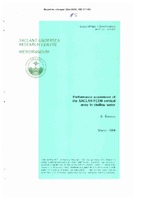| dc.contributor.author | Bassias, A. | |
| dc.date.accessioned | 2018-10-11T14:06:20Z | |
| dc.date.available | 2018-10-11T14:06:20Z | |
| dc.date.issued | 1994/03 | |
| dc.identifier | 1760 | |
| dc.identifier.govdoc | SM-277 | |
| dc.identifier.uri | http://hdl.handle.net/20.500.12489/228 | |
| dc.description.abstract | In this memoranduin the performance of the SACLANTCEN vertical | |
| dc.description.abstract | array is assessed, based on an analysis of experimental dat,a collected in shallow water during the October-November 1991 Signal Processing Group sea trial. The measures that have been used for t,he assessment of the performance of the vertical array, as well as for the evaluation of the quality of the data, for both the signal and noise fields, seen from both signal processing and statistical points of view, constitute a method that leads to the conclusion whether the array performed as expected. These measures are a survey of the sensors' | |
| dc.description.abstract | outputs in the time-domain, computation of spectra both for the signal (plus noise) and purely noise parts, computation of the auto-correlation functions for the sensors' outputs as well as the cross-correlation functions between outputs of selected sensors, and computation of histograms from both signal arid noise samples. Furthermore, by treating the received signals at the array - which | |
| dc.description.abstract | were test signals - as wideband plane waves, their approximate directions of arrival (DOA) are estimated by using two different methods. The first method is the classical broadband beamforming algorithm and the second method is | |
| dc.description.abstract | the coherent signal-subspace (CSS) method, both in the frequency domain. | |
| dc.description.abstract | Thc usefulness( besides the apparent one) of the results of the DOA estimation in the problem of estimating the coherence of the array (vertical or tilted positioning) is discussed. Finally the array gain, based on the experimental data, is computed and compared with the theoretical one as another important measure which is an indicator that the array would be fit for its intended use. The noise field along with its vertical directivity are proven to be decisive factors in the above computation, and therefore in the assessment of the array's performance. | |
| dc.format | vi, 50 p. : ill. ; 197 fig. | |
| dc.language | English | |
| dc.publisher | NATO. SACLANTCEN | |
| dc.subject | Sonar arrays | |
| dc.subject | Signal processing | |
| dc.subject | Beamforming | |
| dc.subject | Fourier transformations | |
| dc.title | Performance assessment of the SACLANTCEN vertical array in shallow water | |
| dc.type | Scientific Memorandum (SM) | |
